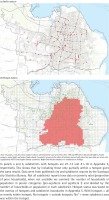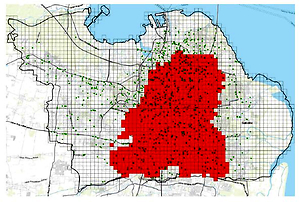INTRODUCTION
Indonesia is among the main contributors to global smokers, with 61.4 million current smokers in 20181. The latest national health survey showed that the smoking prevalence among adults aged ≥15 years remained high at 34% in 2018 and that among youth aged 10–18 years it increased from 7.2% to 9.1% in the period 2013–20182. The proportion of adult smokers, who started very early at age 5–9 years, more than doubled from 0.6% to 1.5% in the period 1995–2013, while those who began at age 10–14 years increased from 9% to 17.3% during the same period3.
One main factor is the lack of comprehensive national tobacco control. Indonesia is still not among the 181 countries that have signed and ratified the Framework Convention on Tobacco Control (FCTC), which provides legal support for comprehensive efforts4. At the national level, there are currently no bans on direct advertisements, point-of-sale advertisements, and product displays. The flagship national program has been the Presidential Decree 109/2012, which encourages local governments to implement a smoke-free policy in selected facilities including those of health, education, and workplace. In these facilities, producing, selling, advertising, promotion and smoking of tobacco products are prohibited. Recent studies, however, showed only 67% of districts (345/514) adopted the policy as of 2018, with considerable variations in compliance rates from 17% in Jayapura to 78% in Bogor city5 (also Wahyuti W, et al, unpublished data, 2019).
Since cigarette advertising is causally linked to cigarette use among youth6,7, many countries have enforced the national ban on outdoor tobacco advertising including the United States (1998), United Kingdom (2003), and Sri Lanka (2006). While there is no such ban at the national level in Indonesia, few districts (15/514) have made the effort, but there are implementation issues such as enforcement and compliance. Banyuwangi district enacted the ban on main roads and sports arenas in 2016, but a survey found high visibility of about 1300 advertisement materials a year later8. There is currently no such evidence in districts without the ban.
Literature is also limited in at least two ways. First, many studies are mainly older (1990s) and from high-income countries such as the United States9-11. Second, since many nations have adopted a national ban on outdoor tobacco advertising since the FCTC in 2005, those studies have not employed the recently developed geospatial techniques. The hotspot analysis, for instance, that uses Getis-Ord Gi* statistics to identify clusters12 has been increasingly used in infectious disease epidemiology research but not much in non-communicable disease, including tobacco control13,14.
This study aimed to provide evidence on the visibility and hotspots of outdoor tobacco advertisements around schools and universities in Surabaya city where there is no advertising ban. Surabaya is the capital city of East Java province and the second largest city of Indonesia, with over 3 million people in 2017. It was among the first district governments to implement smoke-free areas banning indoor smoking in selected facilities including schools since 200815. However, it is currently lagging in more comprehensive tobacco control measures.
METHODS
We conducted a geospatial analysis of the visibility and hotspots of outdoor tobacco advertisements around schools and universities in Surabaya. There are two primary data: advertisement and educational facility data.
First, we collected data on large and medium-sized advertisements during October–November 2018 by surveying over 250 registered roads and streets (as per the mayor’s regulation number 70 of 201016) using motorcycles and cars. Variables included geocodes (latitude and longitude), types (videoboard, billboard, and banner), brand/product name, and picture. We used Google My Location App on smartphones to obtain the geocodes17,18.
Second, educational facility data include a comprehensive list of government and private schools and universities in Surabaya. We obtained the school data from the website of the city education office with variables: school name, level (primary, junior high, and senior high), ownership (government, private), and address. We obtained the university data from the website of the national higher education office with similar variables. Both school and university data were as of December 2018. We used Google Sheets and geocoding addons to convert the addresses into geocodes. Also, we collected published subdistrict demographic and socioeconomic data from the Statistics Bureau of the city.
The geographical analyses were conducted in ArcMap 10.6 using the World Topographic Map as a basemap. We used several geospatial tools: 1) geoprocessing/buffer tool to generate buffers of 100 m and 300 m around advertisements19-21; 2) spatial join tool to calculate the number of advertisements that have at least one school within a buffer; 3) spatial join and dissolve tools to produce number of schools within an advertisement buffer; 4) kernel density tool to generate heatmap of advertisements and optimized hotspot analysis tool to produce the hot spots (defined as significant clusters with a high number of advertisements using 95% significance levels); and 5) spatial join tool to produce number of schools/universities within hot spots. In the analyses, we represented each advertisement and facility as a point on the map while government universities as polygons because of typically larger areas.
RESULTS
Table 1 shows the descriptive statistics of outdoor tobacco advertisements and educational facilities of our analysis. There were 307 large and medium-sized advertisements, which included billboards (63%), banners (31%), and videoboards (7%) (Appendix 1 shows sampled pictures). The three most prominent companies, including local companies such as PT. Djarum and PT. Gudang Garam and global companies such as PT. HM Sampoerna (Philips Morris International) owned most of the advertisements (90%). There were 1287 educational facilities, including 1199 schools and 88 universities. Over half of the schools were at the primary school level, and two-thirds were private. Over 90% of universities were private.
Table 1
Outdoor tobacco advertisements and educational facilities in Surabaya city, 2018
[i] One advert was excluded because it was outside of the city boundary used for spatial analysis. Other companies include PT. Bentoel International, PT. Wismilak, PT. Karyadibya Mahardika, PT. Kolang Citra Abadi, and PT. Nojorono Tobacco. The University of Airlangga has three separate campuses (counted as three facilities) but Sepuluh November Institute of Technology, the State Polytechnic in Electronics, and the State Polytechnic in Marine Engineering were within the same campus complex so were counted as one facility.
Figure 1 (panel a) shows the visibility of outdoor tobacco advertisements using buffer analysis. The red dots show outdoor tobacco advertisements and grey lines show dissolved buffers of 100 m (about 5-minute walk) and 300 m (about 10-minute walk) around schools. This result shows a high visibility of advertisements around school buffers. Table 2 shows the number of educational facilities with at least one advertisement inside school buffers and the number of advertisements within dissolved school buffers. Results show that 27% of schools (326/1199) and 31% of universities (27/88) had at least one advertisement within 300 m from the facility. By ownership, visibility was similar between government and private schools, but it was higher around government universities (57% vs 28%, of government and private universities, respectively, had at least one advertisement within 300 m). Moreover, results also show that 78% of advertisements (239/307) and 11% of advertisements (11/307) were just 300 m from schools and universities, respectively. There were more advertisements around private schools (188 advertisements or 61% of total) and around primary schools (209 advertisements or 68% of total).
Table 2
Number and proportion of educational facilities and outdoor tobacco advertisements related to buffers
Figure 1
Visibility and hotspots of outdoor tobacco advert around educational facility in Surabaya, 2018

Figure 1 (panel b) shows the hotspots of outdoor tobacco advertisements using hotspot analysis. The green dots are schools, and the red-shaded areas are the hotspots (i.e. areas with significantly higher density of ads). Results show that the middle part of the city has a significant (95% level) clustering of advertisements (the default ArcMap result is given in Appendix 2). This clustering is also shown in the kernel density map in Appendix 3. Table 2 shows the number and proportion of educational facilities within the hotspots. Results show high visibility around facilities, with 54% of schools (652/1199) and 67% of universities (59/88) inside the hotspot areas. Results also show that 57% and 53% of government and private schools were within hotspots, respectively, while the corresponding universities were 86% and 65%, respectively. To better understand the hotspot areas, Table 3 shows the characteristics of subdistricts with and without advertisement hotspots. We overlaid the hotspots with the subdistrict boundary map and defined subdistricts with hotspots if all or most of a subdistrict area is within the hotspot. Twelve of 31 subdistricts in the city were defined as hotspots (Appendix 4). We then summarized the demographic and socioeconomic characteristics of areas with and without hotspots (Appendix 5). Results show that the subdistricts with hotspots are, on average, more densely populated (20333 vs 7532 people per km2) and have higher poverty rates (21.6% vs 16.9%) compared to those without hotspots.
Table 3
Characteristics of subdistricts with and without advertisement hotspots
DISCUSSION
There was high visibility of large and medium-sized outdoor tobacco advertisements around educational facilities in a city without the ban. Many of those advertisements were large billboards and videoboards, from which young people were more likely to recall information, relative to smaller advertisements22. Almost 80% of those advertisements were about 10 minutes away from primary schools and high schools in the city, and more than half of schools and two-thirds of universities were inside the advertisement hotspots. Also, most of the advertisements were owned by the three biggest tobacco industries in the country, which have marketed cigarettes aggressively and attractively, especially to the youth23-25. All this encourages receptivity and favoritism to advertisements, which has shown to increase tobacco use among young people7,26. Results also show significant hotspots of ads, particularly in the middle areas of the city that are shown to be more densely populated and more impoverished. This could contribute to the increasing tobacco use among poorer populations, particularly youth27.
For global tobacco control, all this supports and justifies the crucial role of an effective ban on outdoor tobacco advertising in reducing exposure to tobacco marketing, particularly to young people. Even in settings that have had regulations to ban outdoor tobacco advertisements, implementation issues like low enforcement and compliance are likely to arise8. For Indonesia, this evidence should serve as a wakeup call for the government to ban outdoor tobacco advertisements, ideally a total ban but at least a near-school ban, in order to halt the increasing trend of smoking prevalence among youth21,28. Currently, only 3% of districts have had some regulations to ban outdoor tobacco advertising. Concerted efforts should be made to extend the ban to the 97% (449) of the districts.
Limitations
Our study has at least two limitations. First, it has not included smaller sized advertisements. Further research should also assess the visibility of those advertisements. Second, this study only analyzed the visibility and hotspots around schools and universities. Further studies should evaluate the visibility beyond schools, including health facilities, places of worship, and markets.
CONCLUSIONS
There was high visibility and hotspots of large and medium-sized outdoor tobacco advertisements around educational facilities in a city without the ban in Indonesia. This evidence supports the important role of an effective prohibition of outdoor tobacco advertisements in reducing the potential exposure to tobacco marketing to young people. This evidence should also serve as a wakeup call for the national and district governments in Indonesia to ban advertisements totally or at least near schools to halt the increasing trend of smoking prevalence among youth.


